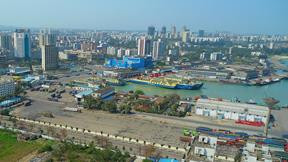China's export growth slowed in October, but it outperformed expectations, thanks to strong global demand ahead of the winter holiday season, improving power shortages, and improved supply chains affected by the ongoing global healthoutbreak.
Imports, on the other hand, fell short of analysts' predictions, indicating a general weakening in domestic demand.
Exports increased 27% from a year ago in October, slightly slower than September's 28% increase. Analysts polled by Reuters had forecast growth would ease to 24.5%.
Strong exports, according to Zhiwei Zhang, chief economist at Pinpoint Asset Management, will help to alleviate the weakening domestic economy and offer the government more leg room to maneuver on economic policy.
"Now that exports provide a buffer to cushion the economic slowdown, the government can afford to wait until the end of the year to loosen monetary and fiscal policy," he said.
Manufacturing appears to be slowing as well, recent data showed. Factory activity fell for the second month in a row in October, with industrial output growth slowing to its lowest level since March 2020, the first wave of the pandemic.
Some supply bottlenecks, such as a power deficit driven by a coal scarcity, stricter pollution regulations, and increased industrial demand, have begun to alleviate in recent weeks as a result of considerable government intervention.
Premier Li Keqiang announced on Tuesday that the government will take steps to boost the industrial sector as the economy continues to contract.
Imports increased 21% year over year in October, accelerating from a 18% increase in September but falling short of estimates for a 25% rally.
Based on data by Goldman Sachs, the value of crude oil imports was up by 56.2% year over year, up from nearly 35% in September, and the value of coal imports soared to 292% year over year, up from 235% in September, as the global energy crisis and post-pandemic economic rebound lifted commodity prices.
Last month, China had its highest-ever trade surplus of $84.54 billion. It was also higher than the $65.55 billion projected in the survey and the $66.76 billion surplus in September.
The world's second largest economy grew nearly 5% from a year earlier in the July-September quarter, the slowest pace since the third quarter of previous year.






